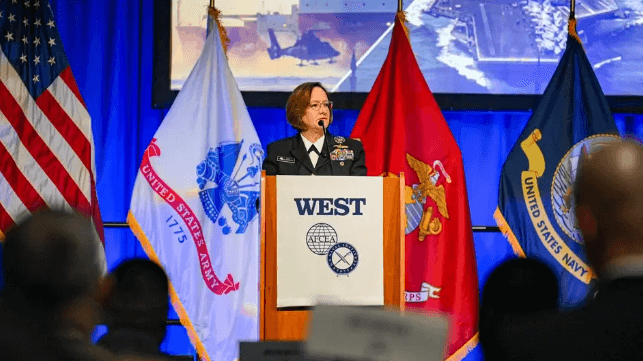U.S. Navy's Top Officer Touts Success of Red Sea Air Defense Mission

The U.S. Navy has shot down 14 anti-ship ballistic missiles (ASBMs) since the start of hostilities in the Red Sea last November, said Adm. Lisa Franchetti in a conference keynote address Tuesday. It is the first time that ASBMs has been used in naval combat, and the first time that they have been shot down in a real-world confrontation.
"They're working tirelessly to preserve the free flow of commerce to date. Shooting down over 70 UAVs, seven cruise missiles, and for the first time in history, 14 anti-ship ballistic missiles. How about that? That's combat power right there," she said.
Despite the air defense screen, some of the ASBMs have gotten through and reached their targets, including the freighter Zografia, the bulker Star Iris, and the tanker Marlin Luanda.
American airmen have also taken down inbound anti-ship drones - quite a lot of them. Capt. Earl Ehrhart V (USMC), a Harrier pilot from the big-deck amphib USS Bataan, has shot down seven to date. (If drones counted as "enemy aircraft," he would be the first American fighter ace since the Vietnam War.)
Many other Houthi munitions have been destroyed on the ground by allied airstrikes, delivered primarily by the carrier USS Dwight D. Eisenhower and Tomahawk-equipped surface combatants off the coast of Yemen.
Franchetti also discussed the changing nature of American sea power. She acknowledged that the Navy now faces an operating environment in which "sea control is neither guaranteed nor freely given," contested "by forces that desire to rewrite the global rules-based order." But she also insisted that the service's deepening numerical disadvantage does not matter, thanks to new technology and the help the service can count on from the Air Force, Marine Corps and the Army.
"It’s not about numbers. It’s about how you put it all together," she said. "It’s platforms on, under and above the sea. It’s the networks that enable them. . . . If you look at some of the things that all of our sister services are doing to get after this challenge of China, and you put all the pieces together, we are the dominant combat warfighting force."
Adm. Franchetti also pointed to the Navy's advances in unmanned vessel technology, as exemplified by the new USV test squadron in U.S. 5th Fleet. The service plans on expanding on these efforts and may train up a new dedicated workforce for robotic systems.
China's navy, the largest in the world, has 350 hulls and is on track to reach 400 by next year. It is the U.S. Navy's primary strategic threat, and has quickly become the standard against which naval capabilities are measured. China's PLA Navy can draw on the vast capabilities of China State Shipbuilding Corporation, the largest civilian (and defense) shipbuilding enterprise in the world. Its fleet is rapidly modernizing with new air-defense destroyers, amphibs, subs, and an expanding carrier aviation program, supplemented by the world's largest owned merchant fleet.
